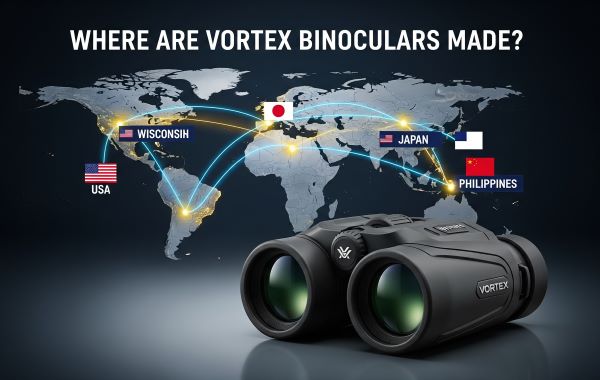



When you’re investing in quality optics, knowing where your binoculars are manufactured matters. The question “where are Vortex binoculars made” reveals a complex global manufacturing network that might surprise you.
Vortex binoculars are manufactured in multiple Asian countries, including Japan, China, Philippines, Taiwan, and Korea. Despite being an American company headquartered in Wisconsin, Vortex produces zero binoculars in the USA, focusing instead on strategic overseas partnerships.
This comprehensive guide reveals exactly where each Vortex model is made, why manufacturing location matters, and how the company maintains quality across its global production network. You’ll discover which models come from which facilities and what that means for your purchasing decision.
Let’s cut straight to the facts about Vortex binocular manufacturing locations. Here’s where your optics actually come from:
• Japan – Premium Razor UHD series only • China – Majority of models including Razor HD, Diamondback HD, Crossfire HD • Philippines – Select Viper models and some Razor HD assembly • Taiwan & Korea – Limited component manufacturing
Contrary to popular belief, no Vortex binoculars made in USA exist currently. While the company maintains its headquarters and design operations in Wisconsin, all binocular production happens overseas.
| Vortex Series | Primary Manufacturing Location | Price Range |
|---|---|---|
| Razor UHD | Japan | $2,000-2,500 |
| Razor HD | China (previously Japan) | $900-1,300 |
| Viper HD | Philippines | $500-700 |
| Diamondback HD | China | $200-400 |
| Crossfire HD | China | $150-250 |
The story of where is Vortex Optics located begins in 1986 in Middleton, Wisconsin. Dan and Margie Hamilton started with a small retail store called “Wild Birds Unlimited,” selling bird feed and quality optics for nature observation.
In 2002, the Hamiltons transformed their retail operation into Vortex Optics, a full-fledged optics manufacturer. The company’s evolution from local retailer to global brand represents a classic American success story.
Today, Vortex’s headquarters sits in Barneveld, Wisconsin, occupying an impressive 280,000-square-foot facility. This location houses 300-400 American employees who handle design, engineering, marketing, and customer service. The facility even includes indoor shooting ranges and a daycare center.
Despite this substantial American presence, the company chose overseas manufacturing for practical reasons. Labor costs, established expertise in optical manufacturing, and existing supply chains in Asia made offshore production the logical choice for competitive pricing.
Understanding the Vortex optics manufacturing location for specific models helps you make informed purchasing decisions. Let’s examine each production facility and its products.
Japan remains the gold standard for optical manufacturing, which explains why Vortex Razor binoculars in the UHD line are exclusively produced there. The Razor UHD series represents Vortex’s pinnacle of optical performance.
Japanese facilities offer:
The premium you pay for Japanese-made models reflects superior materials, tighter tolerances, and enhanced optical performance. These facilities produce lenses that deliver exceptional edge-to-edge clarity and color fidelity.
The majority of Vortex’s binocular lineup comes from Chinese factories. This includes popular models across multiple price points:
Models manufactured in China:
Initially, Chinese production faced quality challenges. According to Vortex representatives, the company addressed this by stationing Japanese engineers and optics experts at Chinese facilities. This supervision ensures consistent quality standards across production lines.
The evolution of Chinese optical manufacturing has been remarkable. Modern facilities now produce binoculars that rival products from traditional manufacturing centers, particularly in the mid-range market segment.
The Philippines represents Vortex’s newest manufacturing frontier. Currently, facilities there produce:
Philippine manufacturing offers a middle ground between Chinese efficiency and Japanese precision. Labor costs remain competitive while quality standards continue to improve under Japanese oversight.
Recent production shifts from China to the Philippines reflect Vortex’s commitment to diversifying its supply chain. This strategic move helps maintain consistent availability and potentially reduces tariff impacts.
The decision to manufacture outside the USA reflects broader industry trends and economic realities. Who makes Vortex binoculars isn’t just about the company name—it’s about creating value for consumers.
Cost considerations drive most manufacturing decisions. Asian facilities offer:
Technical expertise particularly matters in optics manufacturing. Japan’s decades-long dominance in camera and optical equipment created an ecosystem of skilled workers, specialized machinery, and component suppliers that’s difficult to replicate elsewhere.
Industry-wide trends show even prestigious European brands increasingly rely on Asian manufacturing for certain product lines. This global approach allows companies to offer quality optics at multiple price points.
The balance between quality and affordability defines modern optics manufacturing. By leveraging global production capabilities, Vortex delivers professional-grade optics at prices accessible to enthusiasts and professionals alike.
Manufacturing location means nothing without rigorous quality control. Vortex optics manufacturing location varies, but standards remain consistent through several key practices.
Daniel Hamilton and his son Sam, a design engineer, regularly visit Asian production facilities. These visits ensure manufacturing processes meet Vortex’s specifications and maintain relationships with suppliers.
Japanese engineers supervise Chinese and Philippine facilities, providing:
Every binocular undergoes testing regardless of origin. Inspection processes check optical alignment, waterproofing, mechanical function, and coating quality before products leave the factory.
The famous VIP (Very Important Promise) Warranty backs every product equally. This unconditional, transferable lifetime warranty demonstrates confidence in manufacturing quality across all facilities. As noted by industry experts, warranty coverage often indicates manufacturing confidence.
Understanding where are Vortex sights made in context requires comparing with competitors. Here’s how major brands approach manufacturing:
| Brand | Premium Models | Mid-Range | Entry Level |
|---|---|---|---|
| Vortex | Japan | China/Philippines | China |
| Nikon | Japan | China | China |
| Bushnell | Japan/Korea | China/Philippines | China |
| Leupold | USA/Japan | Philippines | China |
| Zeiss | Germany/Japan | Japan | China |
This comparison reveals industry-standard practices. Even prestigious European brands utilize Asian manufacturing for certain product lines. The key differentiator isn’t location but quality control implementation.
Vortex’s approach mirrors industry leaders by reserving Japanese production for flagship models while leveraging other facilities for volume production. This strategy maintains quality while offering competitive pricing across product tiers.
Several myths persist about Vortex’s manufacturing practices. Let’s address the most common misconceptions with facts.
Despite being an American company, Vortex manufactures zero binoculars domestically. The Barneveld facility handles design, assembly of select riflescopes, and the UH-1 holographic sight—but no binocular production.
Plans for domestic binocular manufacturing have been discussed but remain unrealized. Economic factors and established overseas supply chains make US production challenging for competitive pricing.
“Assembled in” doesn’t indicate inferior quality. Philippine facilities operate under the same quality standards as other Vortex factories, with Japanese supervision ensuring consistency.
Assembly location differs from component origin. Premium glass elements might come from Japan while assembly occurs in the Philippines, combining quality components with efficient production.
The shift of where is Vortex Diamondback made and Razor HD production from Japan to China sparked controversy. However, this move allowed significant price reductions while maintaining optical quality through improved Chinese manufacturing capabilities.
Original Razor HD models cost $1,500-1,800 when Japanese-made. Current Chinese-produced versions retail for $900-1,300, making premium optics more accessible without sacrificing performance that matters to users.
Determining your binoculars’ origin requires checking specific locations on the product. Manufacturing information appears in several places:
Where to look:
Understanding labeling helps interpret manufacturing information:
Production location can change over model years. A 2018 Razor HD might show “Made in Japan” while a 2023 model shows “Made in China,” reflecting production shifts.
The landscape of who makes Vortex optics continues evolving. Several trends shape future manufacturing decisions.
Vortex’s expanded Barneveld facility suggests potential for increased domestic production. While binocular manufacturing remains unlikely, expanded riflescope assembly shows growing US capabilities.
Industry trends point toward:
Market demands for “Made in USA” products create pressure for domestic manufacturing. However, establishing competitive binocular production requires massive infrastructure investment that may not prove economically viable.
Vortex Optics designs all products in Wisconsin, USA. Manufacturing partners in Japan, China, and the Philippines produce binoculars under Vortex specifications and quality control supervision.
Vortex Optics headquarters is located in Barneveld, Wisconsin, USA. The 280,000-square-foot facility houses design, engineering, customer service, and limited manufacturing operations for select products.
Yes, Chinese-made Vortex binoculars maintain excellent quality through Japanese engineering supervision, strict quality control, and the same VIP warranty as premium models. Modern Chinese facilities produce optics meeting international standards.
Japanese-made models (Razor UHD) feature premium components, tighter tolerances, and superior coatings. Chinese-made models offer excellent value with slightly less refined optics but still exceed requirements for most users.
All current Vortex Diamondback HD binoculars are manufactured in China. The popular Diamondback line represents Vortex’s volume production, benefiting from economies of scale in Chinese facilities.
Understanding where Vortex binoculars are manufactured reveals a sophisticated global production strategy. From Japanese precision for premium Razor UHD models to efficient Chinese facilities producing Diamondback HD series, each location serves a specific market segment.
The key takeaway? Manufacturing location matters less than quality control implementation. Vortex maintains consistent standards across all facilities through engineering oversight, rigorous testing, and comprehensive warranty coverage.
Whether you’re considering Japanese-made Razor UHD binoculars or Chinese-produced Crossfire HD models, focus on optical performance and features that match your needs. The VIP warranty protects your investment regardless of manufacturing origin.
Choose your Vortex binoculars based on intended use, budget, and desired features—not manufacturing location alone. Quality optics come from quality processes, not just prestigious addresses.







